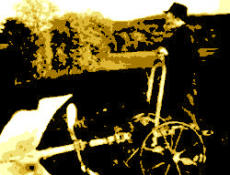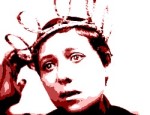Film Review
Farrebique ou Les quatre saisons
is one of the most remarkable French films of the 1940s, certainly one
of the least expected. More than just a documentary, it is an
invaluable ethnological study into a people and a way of life that have
by now become extinct, their existence barely perceptible in what we
observe in the countryside today. The nearest thing to this
cinematic one-off is Raymond Depardon's
Profils paysans (2001-8), a
series of portraits charting the decline of traditional farming methods
in France at the start of the third millennium.
Farrebique is not a conventional
documentary (it lacks the rigorous objectivity of Depardon's
films). Rather, its director Georges Rouquier appears to have
modelled it on Robert J. Flaherty's
Nanook of the North (1922),
combining slices of life filmed
sur
le vif with a fictional narrative and some dazzling lyrical
interludes.
This was Rouquier's first full-length film, and unquestionably his
best. Whilst
Farrebique
was not the commercial success it deserved to be, it is now highly
regarded and was honoured with the FIPRESCI prize when it was screened
(out of the competition) at the first Festival de Cannes in 1946.
Rouquier had to wait 38 years before he could realise his ambition of
making a sequel,
Biquefarre
(1984), the last film he made before his death in 1989.
Farrebique is a uniquely poetic
film that is as much a meditation on the cycles of human existence as
it is an insightful portrait of the life of peasant farmers circa 1940.
The film's authenticity is helped by Rouquier's decision to film a real
farming family rather than employ professional actors. The
grandfather who appears in the film was Rouquier's uncle, and the owner
the farm where most of the film is set. The rest of the cast
comprises other family members and neighbours.
Farrebique is at its most
effective, and affecting, when Rouquier films the farmers going about
their daily routine - making bread, ploughing the fields (with
oxen-pulled ploughs), gathering the harvest by hand and feeding a
steam-powered threshing machine. These are raw snatches of life
that we recognise from classic literature but seldom glimpse 'for real'
on film, and witnessing them is quite a moving experience. Life
may appear hard for all of the individuals we see, but we can hardly
fail to be envious of their wondrous proximity to nature. Today
humankind seems to be so disconnected from the natural world, but in
this film we observe men, women and children living as part of nature's
tapestry, sharing the same heartbeat, the same pulse of life.
In the film's most lyrical passage, the birth of a baby in the
springtime forms part of a spectacular montage of accelerated shots
depicting the flourishing of new life after the passing of winter -
seeds germinating, ferns unfurling, early flowers blossoming, birds
laying their first eggs... Mirroring this triumphant celebration
of life is the lament of death that comes with the onset of winter
towards the end of the film. As the old patriarch releases his
mortal bonds, we hear the mournful sound of a tree being felled - a
poignant reminder of human mortality and our modest place in the scheme
of things.
Where the film stumbles slightly is with its scripted passages. As
in Flaherty's film, these feel a tad forced and contrived, weakening
the film's integrity just a little. The younger son's
courtship, the patriatch's sudden death and subsequent dispute over
what will then happen to the farm - these are soap-style embellishments
but they do lend a structure to the
film and reinforce the impression that time is marching on.
Change is what the film is primarily about and the most dramatic sign
of change is the death of a language that has served countless
generations. Whilst the older members of the family can speak
fluently only in their regional patois (occitan rouergat), their
grandchildren speak only in standard French. We are moved not
only by the obvious gulf that exists between generations who cannot
communicate with one another, but also by the realisation that an
ancient language is dying out right in front of our eyes. It was
seventy years ago that
Farrebique
was filmed, in the immediate aftermath of WWII, but watching it today it
seems like we are looking back into a long distant century, to see a
world that is now as alien to us as the surface of some unknown faraway
planet - a world that is strangely attractive...
© James Travers 2015
The above content is owned by frenchfilms.org and must not be copied.
Film Synopsis
The Aveyron district of southern France is noted for its high rocky plateaus
which give the countryside a distinctive, almost Neolithic character.
Visiting the region you have a sense that it hasn't changed for millennia,
that it exists in a bubble that has somehow been untainted by centuries of
human progress. In the 1940s, when filmmaker Georges Rouquier made
his documentary
Farrebique ou Les quatre saisons, farming methods
in this region of France had remained unchanged for generations, but whilst
many still remained doggedly committed to the old traditions, a few were
beginning to adopt new ways of farming.
Immediately after the Liberation, Rouquier spent a full year with one community
of farmers, following them across four seasons. The film he made is
a fascinating pictorial record of a way of life that has now completely disappeared,
a time capsule showing man living in accord with the rhythms of nature.
Before the advent of electricity, modern machinery and artificial methods
of growing crops, man had to work with nature and cope as best he could with
this, the most temperamental and unforgiving of mistresses. It was
a precarious and often brutal mode of existence, but in some ways it was
a richer, more satisfying life. Perhaps Rouquier's film has a message
for future generations...
© James Travers
The above content is owned by frenchfilms.org and must not be copied.


